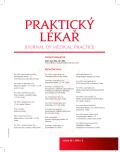Fine motor skills disorders in general practice
Authors:
E. Bačová 1; L. Bačová 2
Authors‘ workplace:
Univerzita Karlova, Praha
1. lékařská fakulta
Klinika rehabilitačního lékařství
Přednostka: doc. MUDr. Olga Švestková, Ph. D.
1; MUDr. Bačová Lenka, s. r. o.
Všeobecná ambulantní zdravotní péče, Uherské Hradiště
2
Published in:
Prakt. Lék. 2016; 96(3): 125-127
Category:
Of different specialties
Overview
The article deals with a possibility of direct cooperation between a general practitioner and an occupational therapist in the care of patients with fine motor skills disorders. It highlights the important role of the general practitioner who search for patients with health disorders during preventive medical check-ups and who take care of patients with acute or chronic diseases. General practitioners daily diagnose illnesses, which have been in the latent stage so far, and they identify the differences between various diseases based on their first symptoms. Early identification of the diagnosis and referral the patient to a specialist has a major impact on the patient´s prognosis. Relatively common disorders, which a general practitioner deals with, are disorders of fine motor skills. They are mostly considered to be symptoms of brain or spinal cord diseases, vascular, infectious, neurodegenerative, posttraumatic conditions, consequences of musculoskeletal system injury. Direct cooperation between a general practitioner and an occupational therapist, neurosurgeon, traumatologist, orthopaedist, rehabilitation doctor, or physiotherapist is common. It seams that physicians are often not informed enough about the occupational therapy subfield. Occupational therapy focuses especially on care of patients with fine motor skills disorders. Direct cooperation of a general practitioner and an occupational therapist would guarantee professional, effective and fast help to patients and their fast return to active life and self-sufficiency.
Keywords:
general practitioner – occupational therapist – cooperation – disorders of fine motor skills
Sources
1. Coupar F, Pollock A, Rowe P, et al. Predictors of upper limb recovery after stroke: a systematic review and meta-analysis. Clin Rehabil 2012; 26(4): 291–313.
2. Dufek J. Profesionální syndrom karpálního tunelu. Neurol pro praxi 2006; 7(5): 254–256.
3. Kolář P. Rehabilitace v klinické praxi. Praha: Galén 2009.
4. Krivošíková M. Úvod do ergoterapie. Praha: Grada Publishing 2011.
5. Lannin NA, McCluskey A. A systematic review of upper limb rehabilitation for adults with traumatic brain injury. Brain Impairment 2008; 9(3): 237–246.
6. Martin JA, Ramsay J, Hughes C. Age and grip strength predict hand dexterity in adults. PLoS One 2015; 10(2): e0117598. Dostupné z: http://dx.plos.org/10.1371/journal.pone.0117598
7. McCombe Waller S, Whitall J. Fine motor control in adults with and without chronic hemiparesis: baseline comparison to nondisabled adults and effects of bilateral arm training. Arch Phys Med Rehabil 2004; 85(7): 1076–1083.
8. Piťha, J. Diagnostické problémy u roztroušené sklerózy z pohledu klinického neurologa. Medicína po promoci [online] 2012; 3. Dostupné z: http://www.tribune.cz/clanek/27111-diagnosticke-problemy-u-roztrousene-sklerozy-z-pohledu-klinickeho-neurologa [cit. 2016-02-15].
9. Přikrylová Vranová H. Biologické a klinické markery poškození nervové soustavy u neurodegenerativních onemocnění: Analýza mozkomíšního moku u pacientů s Parkinsonovou nemocí. Disertační práce. Olomouc: Lékařská fakulta Univerzity Palackého v Olomouci 2011. Dostupné z: http://theses.cz/id/xxm805/Dizertace_-_Pikrylov.pdf [cit. 2016-03-02].
10. Vyskotová J., Macháčková K. Jemná motorika: Vývoj, motorická kontrola, hodnocení a testování. Praha: Grada Publishing 2013.
Labels
General practitioner for children and adolescents General practitioner for adultsArticle was published in
General Practitioner

2016 Issue 3
Most read in this issue
- Fine motor skills disorders in general practice
- Larva migrans cutanea – an imported skin disease and possibilities of treatment
- New oral anticoagulants – a review
- Ankle brachial index and its interpretation in diabetic patients
